Cliffe Castle Museum
 Cliffe Castle Museum, Keighley | |
| Established | ca.1892 as Keighley Museum. Reopened in 1959 as Cliffe Castle Museum. |
|---|---|
| Location | Spring Gardens Lane, Keighley, West Yorkshire, England BD20 6LH |
| Type | Heritage centre, Historic house museum. |
| Visitors | 65,000 (2010 |
| Public transit access | Keighley railway station; bus information from Bradford Interchange |
| Website | www.bradfordmuseums.org |
Cliffe Castle Museum, Keighley, West Yorkshire, England, is a local heritage museum which opened in the grand, Victorian, neo-Gothic Cliffe Castle in 1959. The museum is the successor to Keighley Museum which opened in Eastwood House, Keighley, in ca.1892. There is a series of galleries dedicated to various aspects of local heritage, and to displaying the house itself. Entrance to the museum is free of charge.
History
It is believed that Keighley Museum was established in 1892, because that is when its first location, Eastwood House, Keighley, was purchased for the public.[1] In 1950 the local benefactor Sir Bracewell Smith purchased Cliffe Castle, and had it redesigned as a museum and art gallery for the people of Keighley.[2] The museum re-opened as Cliffe Castle Museum and Art Gallery in 1959.[3]
The Cliffe Castle building
Cliffe Hall was built by Christopher Netherwood between 1828 and 1833, and designed by George Webster of Kendal, a gothic revivalist. The Butterfields, a textile manufacturing family, bought Cliffe Hall in 1848. Henry Butterfield transformed the building by adding towers, a ballroom and conservatories from 1875 to 1880, and renamed it Cliffe Castle in 1878. He decorated the building with the griffin motif, which he had adopted as a heraldic crest.[4]
In 1949 the building and grounds were bought by Keighley Corporation with the assistance of Sir Bracewell Smith, a local benefactor, who in 1955, paid for the conversion of the house for public use. The house had been gabled in the neo-gothic style, with tall towers each end, and conservatories. In the interests of modernisation, the back tower was taken down, and the front one shortened. The high Flemish gables and other decorations were removed from the roof, and the conservatories demolished. The service rooms were replaced by the octagonal art gallery in the 1950s. The exterior fantasy design was lost but some of the neo-gothic interior has been recreated.[4]
 Victorian Gothic Revival gateway arch and pedestrian entrance to the park in which the Museum is located.
Victorian Gothic Revival gateway arch and pedestrian entrance to the park in which the Museum is located.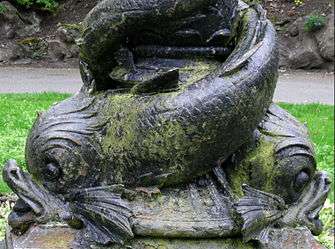
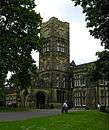 Cliffe Castle Museum, side view.
Cliffe Castle Museum, side view.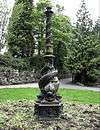
 Weather-sculpted moorland stones at entrance to grounds of Museum.
Weather-sculpted moorland stones at entrance to grounds of Museum. Weather-sculpted moorland stones at entrance to grounds of Museum.
Weather-sculpted moorland stones at entrance to grounds of Museum.
The galleries and rooms
Entrance vestibule
The vestibule and staircase show the Victorian eclectic Gothic Revivalist taste. The hammer beam roof over the staircase imitates the 15th century, the staircase window the 14th century, and the vestibule arches the 13th century.[4]
The window was designed by Powells of Leeds. The top roundel features a copy of Raphael's Madonna and Child. All ten main lights of the window once contained Victorian figures in Tudor costume, but most of these were removed by Frederick Butterfield, to be replaced with clear lights or small roundels.[4]
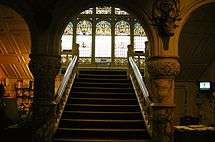 Victorian Gothic Revival vestibule with faux-marbled pillars, staircase and stained glass window.
Victorian Gothic Revival vestibule with faux-marbled pillars, staircase and stained glass window.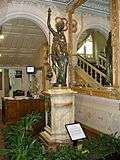 Monumental conical pendulum clock by Eugène Farcot, sculpture by Albert-Ernest Carrier-Belleuse. Purchased at the 1878 Paris world fair, in vestibule.
Monumental conical pendulum clock by Eugène Farcot, sculpture by Albert-Ernest Carrier-Belleuse. Purchased at the 1878 Paris world fair, in vestibule. First floor landing view of stained glass window with chandelier above staircase. View at max resolution to see Madonna and Child in top roundel.
First floor landing view of stained glass window with chandelier above staircase. View at max resolution to see Madonna and Child in top roundel. 1875–1880 neo-Gothic stained glass window above staircase, featuring portraits of Butterfield family in 16th century costume.
1875–1880 neo-Gothic stained glass window above staircase, featuring portraits of Butterfield family in 16th century costume.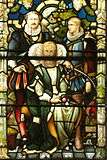 1875–1880 stained glass window over staircase, featuring Butterfield family in 16th century costume.
1875–1880 stained glass window over staircase, featuring Butterfield family in 16th century costume.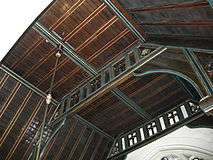 Victorian Gothic Revival hammer beam roof in 15th century style.
Victorian Gothic Revival hammer beam roof in 15th century style.
Reception rooms
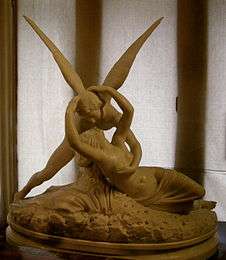
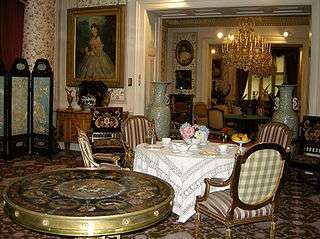 Victorian drawing room display of furniture and fittings, in Reception Rooms.
Victorian drawing room display of furniture and fittings, in Reception Rooms.
Great Drawing Room
In the vestibule and reception rooms are life-size portraits of Napoleon III and Empress Eugenie.
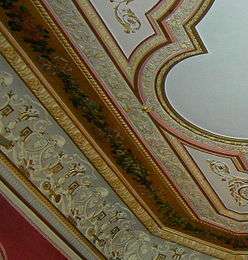 Victorian painted plaster ceiling (closeup), Great Drawing Room.
Victorian painted plaster ceiling (closeup), Great Drawing Room. Victorian painted plaster ceiling in Great Drawing Room.
Victorian painted plaster ceiling in Great Drawing Room.
Working Landscapes gallery
This gallery displays local crafts and trades of the past. There is a video of clog-making which continued into the 20th century.[2]
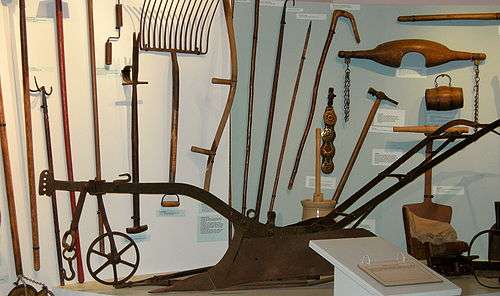

 Victorian carved sandstone lintel featuring a boar's head and oak leaves as a heraldic crest, from Keighley area.
Victorian carved sandstone lintel featuring a boar's head and oak leaves as a heraldic crest, from Keighley area. Victorian hand-loom, in Timmy Feather's (d.1910) Workshop.
Victorian hand-loom, in Timmy Feather's (d.1910) Workshop.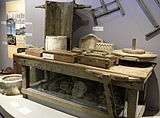 Victorian pipe-worker's workbench.
Victorian pipe-worker's workbench.
Airedale gallery
The display shows how the River Aire was formed, and shows fossils of its earliest animals.[2]
 Fossil amphibians display.
Fossil amphibians display. Educational fossil display.
Educational fossil display.
Archaeology Area gallery
Besides the exhibits shown below, this display features the Silsden Roman treasure.[2]
Natural history gallery
This was once the Butterfields' ballroom, and this is where the white lace 1880s dress in the Costume gallery was worn.[6] It is now full of mounted animals and birds. There is a family of tawny owls and a birdsong display.[2] The mounted emu given by Ilkley Museum in 1928 is no longer evident, but there are many other fine examples of the taxidermist's craft.

Molecules to Minerals gallery
This beautifully arranged and classified display was created in 1988,[7] and incorporates collections from several museums in the Bradford area.[1] It includes the cherished Ellison Collection, given by Ilkley Museum in 1928.[8] Very few of the collections are named in the display.
Some of the more glamorous specimens are from the Hinchcliffe Collection. This comprises 800 specimens from the Gem Rock Museum at Heaton, Bradford, bought with grants and public subscription from George Hinchcliffe in 1984. The display explains how minerals are different from rocks, and has sections about: mineral colour; streak; hardness; magnetism; fluorescence; fracture; chemical classification; crystal shape, crystallisation, chemistry and occurrence.[7]
There are over a thousand specimens here, including a display of glowing rocks. It is "still considered one of the best displays between London and Edinburgh".[7]
 Minerals display: close-up.
Minerals display: close-up. Minerals display, including coloured agates.
Minerals display, including coloured agates.
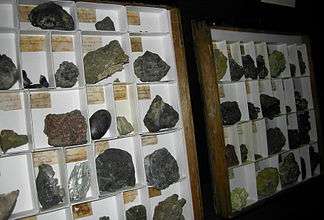 Mineral collection labelled by Joseph Dawson in 1810.
Mineral collection labelled by Joseph Dawson in 1810.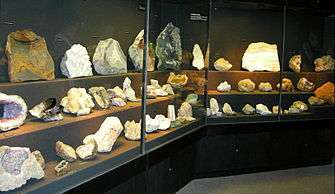 Extensive and brightly coloured minerals display.
Extensive and brightly coloured minerals display.
Sir Bracewell Smith Hall
This space was created in the 1950s when the castle was converted to a museum.
It was restored to its original colour scheme in 2013,and the Octagonal lantern returned to its former position in the hall. The Octagonal lantern was specifically designed for the space by Sir Albert Richardson in the 1950s, who was the architect who led the conversion of the building. It is sometimes incorrectly referenced as a 19th-century Chinese lantern.
The colour scheme and gilding was restored on the basis of paint scrapings, confirmed by a painting of the hall design done by Sir Albert Richardson, which can be seen within the space itself.
Prior to refurbishment, the space was used to host temporary exhibitions, it now displays a permanent selection of items that have been selected from the museum collections.[9]
The Egyptians gallery
The display includes a mummy of an Egyptian girl of ca.250 bce, and covers the Ancient Egyptian belief in the afterlife.
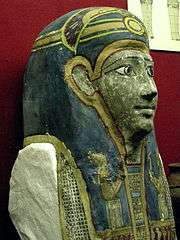 Ancient Egyptian mask from mummy, side view.
Ancient Egyptian mask from mummy, side view. Ancient Egyptian artefacts display.
Ancient Egyptian artefacts display. Ancient Egyptian mask from mummy, front view.
Ancient Egyptian mask from mummy, front view.
Breakfast Room
This downstairs room acts as an accessible space for themes covered upstairs.[2]
Conservatory
This room contains a small selection of larger exhibits and is often used as a teaching or activity room. Exhibits in the conservatory include a marble statue of the Virgin Mary and Child, that originally belonged to Henry Isaac Butterfield and was returned to the Castle by St Annes Church, Keighley. Recent additions include the a wooden First World War memorial plaque from the Temple Street Methodist Church Keighley which accompanied the Morris memorial windows that are now installed in the Stained Glass gallery[10]
Stained Glass gallery
This gallery contains some of the earliest William Morris stained glass in the country.[2]
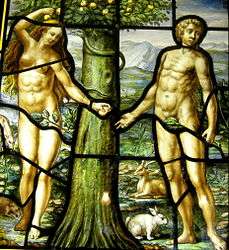 Neo-Gothic 19th century or earlier copy of Albrecht Altdorfer painted glass window featuring Adam and Eve. From West Riddleston Hall, Riddleston.
Neo-Gothic 19th century or earlier copy of Albrecht Altdorfer painted glass window featuring Adam and Eve. From West Riddleston Hall, Riddleston. Detail of Dante as mourner from 1876 Crucifixion window by Edward Burne-Jones for Wm Morris. From St James Church, Brighouse. Possibly in homage to Doré who was in England in the 1870s.
Detail of Dante as mourner from 1876 Crucifixion window by Edward Burne-Jones for Wm Morris. From St James Church, Brighouse. Possibly in homage to Doré who was in England in the 1870s.
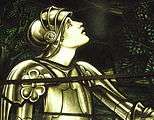 Detail from stained glass war memorial window designed 1921 by John Henry Dearle for William Morris. From Temple Street Methodist Chapel, Bradford area.
Detail from stained glass war memorial window designed 1921 by John Henry Dearle for William Morris. From Temple Street Methodist Chapel, Bradford area.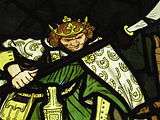 Detail from window illustrating Death of Sir Tristram, designed by Ford Madox Brown (1821–93) for William Morris. From building in Bradford area.
Detail from window illustrating Death of Sir Tristram, designed by Ford Madox Brown (1821–93) for William Morris. From building in Bradford area.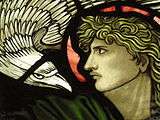 Detail of St John in window designed by Edward Coley Burne-Jones in 1874 for William Morris. From St James Church, Brighouse, near Bradford.
Detail of St John in window designed by Edward Coley Burne-Jones in 1874 for William Morris. From St James Church, Brighouse, near Bradford.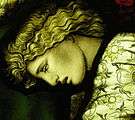 Detail of figure looking down from Crucifixion window by Edward Burne-Jones 1876 for William Morris. From St James Church, Brighouse, nr Bradford.
Detail of figure looking down from Crucifixion window by Edward Burne-Jones 1876 for William Morris. From St James Church, Brighouse, nr Bradford.
Keighley Stories gallery
This gallery aims to tell the story of Keighley. It also, in passing, helps to retain a sense of local identity in the populace, who continue to return from far away to re-live the pleasures of their childhood by seeing again the exhibits which they remember from long-ago visits to the Museum. This is the gallery to which they bring their grandchildren. It is therefore a more important gallery than it might first appear. It includes the Keighley Hen Pecked Club's peace box. This is an adult-sized wooden rocking cradle, supposedly for soothing nagging wives instead of babies. It had humorous rules and was displayed in galas, but it is not known whether it was used. The club used to meet at the Royal Hotel, Damside, and was started by Henry Hargreaves Thompson, who was landlord in 1861. The pub became the Royal Oak in 1998.[11]
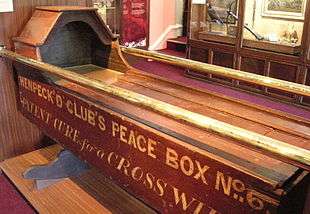
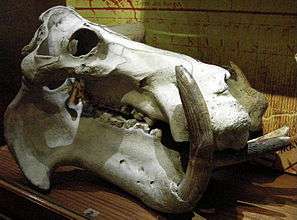 Hippopotamus amphibius skull, thought to have been given to Keighley Museum by Ilkley Museum (now the Manor House Museum) in 1928, due to lack of space.
Hippopotamus amphibius skull, thought to have been given to Keighley Museum by Ilkley Museum (now the Manor House Museum) in 1928, due to lack of space.
Bees gallery
 Working beehive (having recently passed a health check) with glass viewing panel.
Working beehive (having recently passed a health check) with glass viewing panel.
Costume Gallery
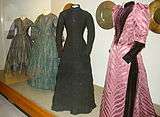 Display of four Victorian dresses.
Display of four Victorian dresses. Display of 1920s–1950s costume (with one 1880s costume on the right).
Display of 1920s–1950s costume (with one 1880s costume on the right).
 1884 evening gown, worn by the Clapham family, Keighley.
1884 evening gown, worn by the Clapham family, Keighley.
This space hosts a changing selection of costume exhibits from the Museum's collections
Mansion to Museum gallery
This gallery, round the top of the octagonal Sir Bracewell Smith Hall, shows the development of the building from a Victorian private house to a contemporary museum. The "Chinese Chandelier", which held the wooden harpies pictured below, once hung in Cliffe Castle.[12] The chandalier has since been restored (with the harpies) and rehung in the Bracewell Smith Hall. It was designed for the space in the 1950s, although often described as 19th century..
 Carved wooden harpies from Chandelier (often described incorrectly as Chinese).
Carved wooden harpies from Chandelier (often described incorrectly as Chinese). 18th century oval vertical sundial from demolished building.
18th century oval vertical sundial from demolished building.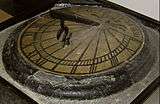 18th century oval vertical sundial from demolished building, side view.
18th century oval vertical sundial from demolished building, side view.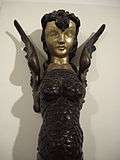 Carved wooden harpy from the chandlier that hung in Cliffe. The chandelier (often incorrectly described as 19th Century Chinese) has since been restored and rehung in the Bracewell Smith Hall.
Carved wooden harpy from the chandlier that hung in Cliffe. The chandelier (often incorrectly described as 19th Century Chinese) has since been restored and rehung in the Bracewell Smith Hall.
Local Pottery gallery
The displays here are placed in recognition of a past local skill, and a trade which was significant in the Keighley area. An alternative tradition to this local industrial tradition was that inspired by Japanese and British Arts & Crafts precedents.
 Victorian pottery made in the Keighley area, including slip trail pottery.
Victorian pottery made in the Keighley area, including slip trail pottery.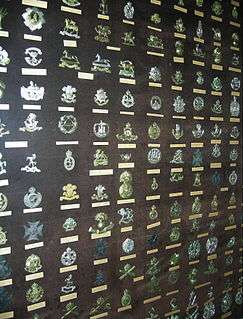 Display of UK military cap badges, in first floor corridor. View full resolution to read labels.
Display of UK military cap badges, in first floor corridor. View full resolution to read labels.
Other aspects of the Museum
- The Friends of Cliffe Castle is the society which has researched and supported much of the restoration and improvement to the Museum which has taken place in recent years. A leaflet about the society is available at the Museum.[13]
- Education programme: School workshops and trails can be booked for Key Stages 1–3, and occasionally for adult and SEN groups.[14]

See also
References
- 1 2 Information from museum staff.
- 1 2 3 4 5 6 7 Leaflet: Cliffe Castle Museum, 2007.
- ↑ "Cliffe Castle Park Conservation Group". www.cliffecastlepark.org.uk. Retrieved 17 January 2016.
- 1 2 3 4 West Yorkshire Archaeology Service, Historic Houses of West Yorkshire: Cliffe Castle Keighley leaflet, 1995.
- ↑ Querns are mentioned in a 1925 description of Ilkley Museum's exhibits (see Ilkley and its Museum 1892–1992 by Edwards and Shillitoe 1992, p.12); some items were handed over to Keighley museum in 1928, and there is no quern on display at Ilkley now.
- ↑ See notice in Costume gallery.
- 1 2 3 Memorandum from A. Armstrong (Natural Science Curator) to Museum staff, 17 May 2002.
- ↑ Gavin Edwards and Denise Shillitoe, Ilkley and its Museum 1892–1992, (1992). (Available at Manor House Museum.)
- ↑ As per interpretation within the hall
- ↑ As at June 2016
- 1 2 "Vale n Dale: Public Houses, Pubs, Beer Houses and Hotels in Keighley". Royal Hotel Damside. Valendale. 2009. Retrieved 27 March 2010.
- ↑ See label on wall of Mansion to Museum Gallery.
- ↑ Leaflet: Friends of Cliffe Castle (available at the Museum).
- ↑ Cliffe Castle Museum website: Education programme page.
External links
| Wikimedia Commons has media related to Cliffe Castle Museum. |
Coordinates: 53°52′31″N 1°54′49″W / 53.87528°N 1.91361°W

